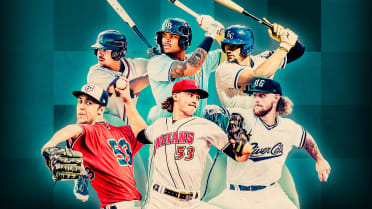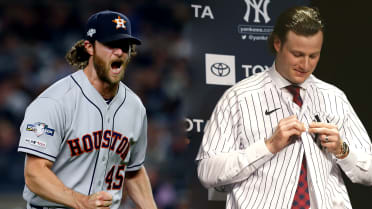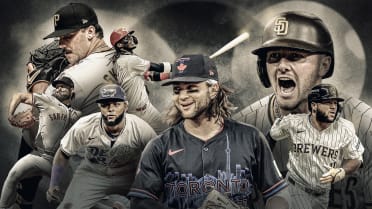Cubs' biggest questions as Hoyer takes over
CHICAGO -- The Cubs came out of a rebuild and emerged as contenders and World Series champions under the front office led by Theo Epstein and Jed Hoyer. Now, the team has reached a critical point in its timeline.
Hoyer has now moved up to president of baseball operations from general manager -- following Epstein's exit last week -- and he is tasked with a challenging situation. The goal is to keep the Cubs among the annual October contenders, while working on building for the team's future.
"We face a new challenge," Hoyer said Monday, "imposed by the reality of our player service time and the realities of our world in 2020. As with all the challenges we have faced here, we will study them, we will use our collective experience, and then we will move boldly to do what is in the best interest of the Cubs."
Here are three pressing questions facing Hoyer:
1. Is the goal to contend in 2021 or build for the future?
Both, and that can be a difficult route for a team to take.
The "player service time" realities that Hoyer mentioned relate to the fact that Javier Báez, Kris Bryant, Anthony Rizzo and Kyle Schwarber are all on pace for free agency next winter. Willson Contreras could follow suit after the 2022 season. Trading from that group could help build for the future.
There is also the fact that the Cubs are entering '21 as the National League Central champions and the division looks very much up for grabs again. Chicago had injuries to its rotation, dramatic bullpen issues early on and extreme offensive problems from key players in '20. Still, the Cubs won the division.
So maybe the Cubs can subtract from their roster -- addressing some future needs in the process -- and still field a playoff-caliber team in '21. Hoyer said that is what he will try to balance as he takes over the front office's lead role.
"Making the playoffs is special, and it does give you a shot to win," Hoyer said. "I don't think every single year you could put together a team that is the favorite to win the World Series. I don't think that's possible, and I think that's probably a fool's errand.
"But I think given our resources and I think given our talent level, I think we should field a team that's playoff-worthy every single year. And I think we can do that and have a team that's positioned long-term as well."
2. Do the Cubs need to make moves to free up payroll?
Teams around baseball have been hit hard financially by the COVID-19 pandemic. The Cubs were no exception, and the losses contributed to layoffs across multiple departments within the ballclub.
With so many uncertainties still in play for the 2021 season, Hoyer said there is no firm budget ceiling just yet. Instead, his discussions with ownership have led to a payroll "range," though Hoyer would not delve into specifics about where the numbers fall.
"We have so many different questions about what life's going to look like in the summer of '21," Hoyer said. "So we have a range that we have discussed. But certainly we haven't been able to really nail anything down specifically. And I think that goes for almost everybody.
"It makes sense that, given the realities of our world right now, there has to be a range because of that uncertainty. So we've had discussions and we'll keep having discussions as we gain more information."
Hoyer would not comment about whether there could be a surprising non-tender decision or get into specifics about player trades. What Hoyer did reiterate and emphasize was the need to keep an eye on the future, which would seem to indicate that moves could loom to get more cost-effective pieces in the fold.
3. Will there be significant changes coming to the Cubs' offense?
While a sample-size asterisk should be placed on any 2020 numbers, the Cubs' team slash line of .220/.318/.387 is hard to ignore. The core group struggled, while Ian Happ and Jason Heyward emerged as the offensive leaders.
The frustrations with the Cubs' lineup are heightened by the fact that there have been little changes to the group in the past few winters. And as the cast has remained relatively the same, the contact rate has gone from 76 percent in '18 to 73.8 percent in '19 to 72.8 percent in '20. Unsurprisingly, the strikeout rate climbed in each of the past two years as well.
The current construction of the roster leaves few holes to fill for '21, barring some trades in the name of both roster and payroll flexibility. Somehow, some way, the Cubs need to shake things up with their offense, especially with a long-term vision in mind.
"We want to look and feel and perform different than we have the last few years," Hoyer said. "So I can't define 'significant' as you might define it, but do I think we need to be different as an offense? No question. And I think we have to identify some of the things we've done poorly and we have to work to improve them.
"That is this game. You're always tackling a new challenge. Nothing's ever perfect. You never have a perfect roster. You never have a perfect situation. And right now, the thing that we're trying to figure out is why we struggle offensively, given the players we have. So, yes, I do think the offense will look different next year."
Senior Reporter Jordan Bastian covers the Cubs for MLB.com. He previously covered Cleveland from 2011-18 and Toronto from 2005-10. Subscribe to his Cubs Beat newsletter.




